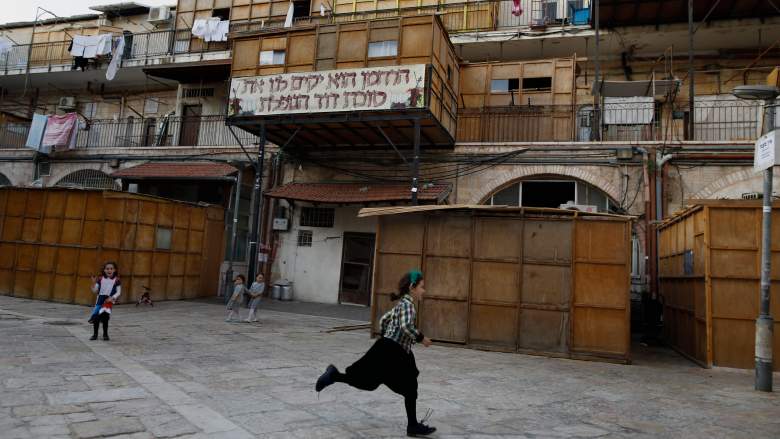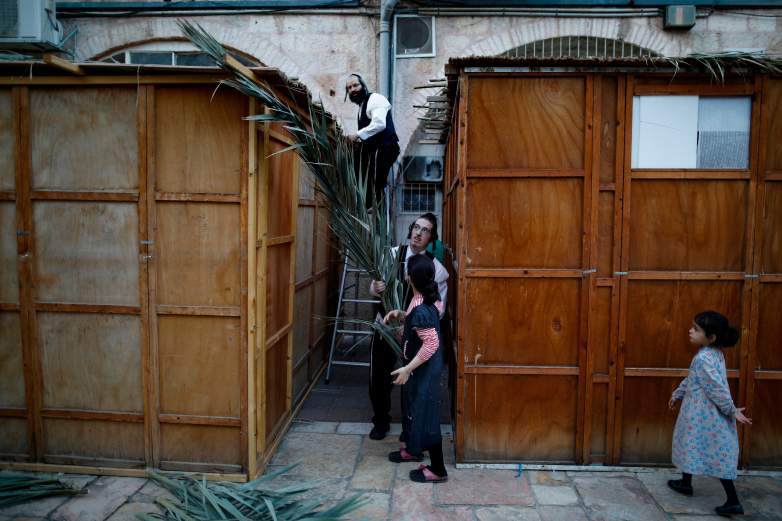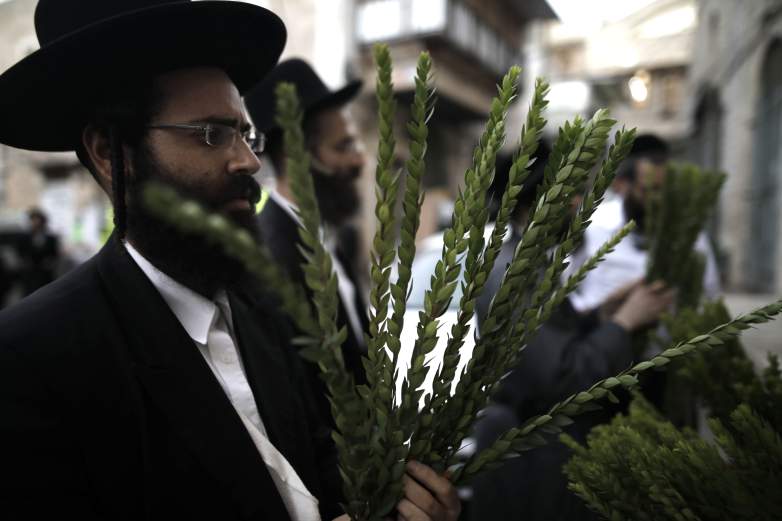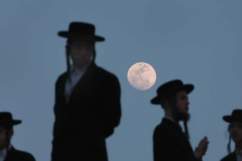
Getty Children play outside their families' Sukkah, the shelters built to celebrate the week-long festival of Sukkot.
After the solemn holiday of Yom Kippur, Jews celebrate Sukkot, a week-long festival. It runs from the 15th day of Tishrei to the 21st day of that month, so it usually falls between late September and early October on the Gregorian Calendar.
The holiday has two meanings. First, it is a celebration of the end of harvest time, as described in the Book of Exodus. Later, the Book of Leviticus mentions a second meaning, so it is also a celebration of the Exodus and how god led the People of Israel out of Egypt.
Sukkot 2017 begins on sundown on October 4 through nightfall on October 11 in Israel. It ends on October 12 outside Israel.
Here’s a look at the meaning of the holiday and its traditions.
1. Its Name is the Plural Form of ‘Sukkah,’ Hebrew for Booth, the Hut Constructed for the Holiday

GettySukkot preparations in Jerusalem.
The word “Sukkot” is plural form of the Hebrew word “sukkah,” which means “booth” or “tabernacle.” This is in reference to the hut or “booth” Jews are supposed to eat in during the festival. As Chabad.org explains, it is made of at least three walls and with a roof typically made of bamboo, palm branches or pine boughs. Jews are supposed to spend as much time in the sukkah as possible during the week.
For the basics on how to build a Sukkah, click here to go to Chabad.org.
While eating meals in the sukkah, a special prayer is recited: “Blessed are You, Adonai our God, sovereign of the universe, who has sanctified us through your mitzvot and commanded us to dwell in the sukkah.” You can find the special Sukkot blessings at JewFAQ.org.
The “booth” is mentioned in the Book of Leviticus. Leviticus 23:42-43 reads, ” You shall live in booths for seven days; all that are citizens in Israel shall live in booths, so that your generations may know that I made the people of Israel live in booths when I brought them out of the land of Egypt: I am the lord your god.”
“You shall observe the festival of weeks, the first fruits of wheat harvest, and the festival of ingathering at the turn of the year,” reads Exodus 34:22.
2. During Sukkot, Jews Also Bring the ‘Four Kinds’ Together
Another important Sukkot tradition is called the arba minimum or “Four Kinds.” As Chabad.org explains, the Four Kinds are a “palm branch (lulav), two willows (aravot), a minimum of three myrtles (hadassim) and one citron (etrog).” You are supposed to bind the first three together. Abra minimum is meant to be a man’s job, but women can also do it.
Jews then say one prayer while holing the lulav, aravot and hadassim in our right hand, unless you are a lefty. Then, with the etrog in your left hand, say another prayer on the first day of Sukkah. When you bring all four together, you have completed the mitzvah.
Next, you can wave the Four Kinds in six directions – south, north, east, up, down and west.
Chabad.org notes that Jewish unity is a theme of Sukkot, and the bringing of the Four Kinds together is a symbol of that. Each represents a different kind of Jew, based on their knowledge of the Torah and observances, according to the site.
3. The Days Between the First & Last Days of Sukkot Are Called ‘Chol Hamoed’
The first two days (or just the first day in Israel) are the most important days of Sukkot and are considered full “yom tov” holidays. This means work is forbidden for Jews on these days.
As Chabad.org explains, the rest of the days are “quasi-holidays.” They are called “Chol Hamoed,” which means “the weekday of the holiday.” Passover, an eight-day festival, also has Chol Hamoed days.
On these days during Sukkot, Jews do take the Four Kinds and eat in the Sukkah, but can work. If one of the days is Shabbat, Jews do not take the Four Kinds.
The celebrations held during the intermediate days of Sukkot are known as “Simchat Beit Hashoeivah.” The last day of the holiday is called “Hoshana Rabbah.”
4. Sukkot Is Followed by Shemini Atzeret & Simchat Torah

GettyAn Ultra-Orthodox Jewish man picks “hadas” in Jerusalem.
Sukkot is part of a series of holidays marking the Jewish New Year and it’s not over yet. On the 22nd Day of Tishrei (October 11 this year), Jews celebrate Shemini Atzeret,” which means “Eighth Day of Assembly.” It
runs two days outside Israel and one day inside Israel.
Shemini Atzeret is followed by Simchat Torah, or “Rejoicing in the Torah.” This celebrates the the completion of the weekly Torah readings. On this day, Jews read the last Torah portion and immediately read the first portion of The Book of Genesis. This shows that the Torah is a never-ending circle.
JewFAQ.org notes that both Shemini Atzeret and Simchat Torah are holidays were JEws are not supposed to work.
5. Israel Decided to Shut off Access to the Gaza Strip & West Bank for 11 Days Because of Sukkot
This year, the Israeli Defense Ministry decided to shut off access to the Gaza Strip and the West Bank for 11 days, The Jewish Post reports. This means all crossings will be closed to Palestinians who legally work in Israel from October 4 through Saturday, October 14, with exceptions for humanitarian and medical reasons.
The Jewish Post explains that Israel usually shuts off the access points for only the beginning and end of a week-long holiday like Sukkot. Defense Minister Avigdor Liberman decided to change that for Sukkot 2017 in response to a shooting in Har Adar, a West Bank settlement. An Israeli border police officer and two Israeli civilian security guards were killed by a Palestinian man.
Al-Haq, a human rights organization in Ramallah, told Al Jazeera that the closure should be considered illegal under international laws.
“The closure does not only prohibit Palestinians from entering Israel. Instead, it also denies them access to occupied East Jerusalem, and sets obstacles and hinders Palestinians’ movement within the West Bank,” Maha Abdullah, a researcher for the group, told Al Jazeera.


